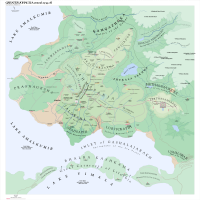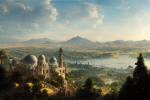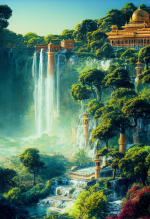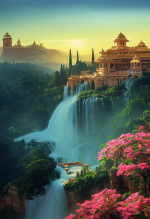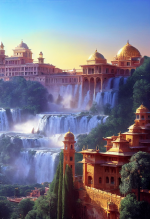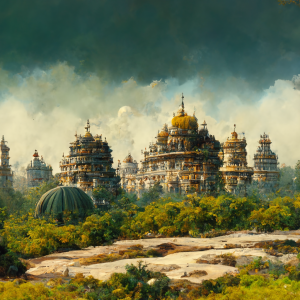City of Johaulia
More properly called the Municipality of Johaulia, the City of Johaulia is also the Capital of the Republic of Johaulia. The name Johaulia is thought to derive from the Kalaman Language name, Jhukhaulya which was anciently the capital of Kalama. Johaulia today includes the later, outer city of Ikwifshi.
The city of Johaulia enjoys the spectacular views of the Great Cataracts of Liluthio which drain Lake Vimala into Lake Amalcumir and thence to the sea. The city of Johaulia proper rests on a peninsula that juts into Lake Amalcumir with the upper falls of Liluthio to the south and the lower falls of Liluthio to the northwest north of the city. The elevation of Lake Amalcumir is 5.3 DF (853 meters) which establishes the lowest elevation of the city.
City of Johaulia Proper
The City of Johaulia Proper consists of Jaloksha, Gahmapanja, Praja Brapar, Lanktipraj, Jakthaparsaphi, and Panjordor. Other cities like Opadsaphi, Lubiyosaphi, Prasnauksha, Aphwarpanja, Ushmawar, Kshampraja, and Shihrbot are not properly part of the City proper of Johaulia, but cities within the Municipality of Johaulia.
- Praj Brapar
[Fortress of the Brasiots]: second fortress of what becomes Johaulia, several lesser contiguous platforms
- Lanktipraj
[Fortress of Silvermoon]: slightly higher fortress, used for sighting the heavens, has Temple of Silvermoon.
- Gahmapanja
[Goha’s high flat foundation, said by legend to have been built by the titan Goha]: largest, high, relatively flat area, ringed by cyclopean stone walls
- Opadsaphi
[Opad’s + saphi “mountain city”]: Fortress with some open areas that clings to the southwest cliff face of Gahmapanja
- Jakthaparsaphi
[mountain city of the Jaktha Tribe, a giant tribe]: rests on higher ground on Gahmapanja.
- Panjordor
[<panja ‘pavement’+ ordor ‘lynxes’] n a higher flat foundation or ‘panja’ on the north end of Johaulia.
- Brunjeher Thuswa
[<Brunjeher ‘?’ + thuswa ‘hunting park’] a vast park located in the middle of Gahmapanj.
- Tephnumë
The walled city of defenders of Johaulia
DISTRICTS
Both Within and Without Johaulia Alchemists District Amantigonyo Dock District Ambassadors District Aracusian District Astrologers District Aviators District Beast-Mongers District Beersellers District Booksellers District Clothmongers District Commoners Lodging District Elissa Bakers District Ezemdoyo Merchants District Fathersayers District Fishermens District Gahma Musicians District Imzaami District Incarnandists District Jaloksha Musicians District Jhelur Commoners District Kawchi-Mongers District Larathi Beastmongers District Little Gorcorumb Little Tishereth Opala Titancraft Manufacturers District Paimbalists District Pepperwheatmongers District Phasha Khoba Jewelers District Pyromancers District Sailors District Scholars District Silkweavers District Spicemongers District Stone-cutters District Talyadhima Gem-Cutters District Tassans District Thuvaki District Theater District Tirtha Kambu Old Families District Titancraft Salvage District Titancrafters District Winemongers District [Zankibusba] Wizards District Zala Gobishi Art District
- Sellers
??? “balsam-sellers” dangdambusba “dangdam leaf sellers” kachchabusba “tea sellers” nakshbusba “fish sellers” shaddashbusba “spice sellers” taktankabusba “adexorn sellers” zankibusba “wine sellers”
- WALLS
Walls of Thukshalaz: These cyclopean walls surround Gahmapanja.
- IZAWDA
An izawda is a steep canyon, typically formed into a high mesa or between two mesas
Izawda Kazgolu: Named after ‘kazgol’, a pinkish kind of jade found in Vimalia and especially in this izawda. Izawda Tumthami:
- CANALS
Jajal Kugartha [Grand Canal of Kugartha, Kugartha or ‘Gartha’ was an ancient King of the Bar Giants]: great canal that receives the many smaller stone canals and ditches which drain the rainfall of much of the higher cities of ancient Johaulia. It runs mainly through Gahmapanja, but starts along the base of Praj Brapar
Jal Ukhrotha [Jal ‘Canal’ + Ukhrotha <Ukhara a giant tribe of supplicants + otha adjectival suffix] n prop the second largest canal in Johaulia. It does not feed into Jajal Kugartha.
- JAMAWA
A towering platform of rock, often reinforced with retaining walls, a jama is a small, but high mesa adjacent to one of the greater high cities of Johaulia. These are typically accessible only by aerobridge or by air.
- THUMBAWA
Zigzags of great stone steps leading up the face of steep canyons and cliffs, the thumbas or ‘thumbawa’ number at least five throughout greater Johaulia.
Kings Thumba Formerly the thumba preferred by the ancient rulers of Kalama
Thumba Alashaya
Thumba Aghanushi
Thumba Aphwar
Thumba Bhara Zuptaj
Thumba Daghanupa
Thumba Gashdathi Leading from Lubiyosaphi to Gahmapraj, these steps are broad and less steep as they are used for beastmongers to traffic their animals to the main city.
Thumba Gershiwa
Thumba Luph [<thumba ‘steps’ + luph ‘merchants’, name for ancient people from Thyria who were merchants] n steps leading up the walls of
Thumba Menjaphya
Thumba Nakshuja [<thumba ‘steps’ + nakshuja ‘of the fishermen’] n steps leading up the walls of northwestern Johaulia
Thumba Panjordor
Thuma Sakhwa
Thumba Siwaroshli
Thumba of the Golden Lady the steps that lead from Praja Brapar to Lanktipraj, just at the foot of the Temple of Lankti Astrologer
Three Thumbawa in Jakthaparsaphi
TOWNS outside of JOHAULIA
- Aphwarpanja [<aphwar (proper name?) + panja, ‘]
- the second largest flat foundation or ‘panja’ lies to the northwest of Gahmapanja.
- Baraparadaj Castle [<Barapar ‘of the Bara giants’ daj ‘Castle] Built over six thousand years ago by the Bara giants, the castle now lies in ruin.
- Bhalasabotta [Bhalasa’s Town] Named after Hesukh’s beast who devoured the Tablets of Destiny, Bhalasabotta is home to the Temple of Hesukh Deliverer.
- Bhalbasaphi [<Bhalba, ‘Cascades’ + saphi, ‘mountain city, town’]
- Chambapraj [Chamba ‘god of springs and ways and means’ + praj ‘high fortress’]
- a smaller fortress in northwest Johaulia
- Chamzurphi [Cham, ‘holy’ + zur, ‘?’, + phi, diminutive] elevated town to the east of Ghala Sakhwa
- Jaloksha [jal ‘canal’ + oksha ‘city’] a large section of districts of southern Johaulia with many converging canals
SITES OUTSIDE OF JOHAULIA but within MAP
- Khamthasaphi Castle
Rests on the heights next to the Great Cataracts of Liluthio, it is now operated by the state government and used to house specialists and facilities for maintaining the safety of the lakes. Apart from aerial transport, it is only possible to access the castle by boat or lake ship.
- Kshampraja [<ksham, ‘sacred fire’ + praja, ‘fortress’] a lighthouse in the peninsula of Shihrbot.
- Lubiyosaphi [Lubiyo’s + saphi “mountain city”]
- walled town clinging to the south face of Gahmapanja
- Omunjara Castle
Rests on the heights next to the Great Cataracts of Liluthio, Omunjara Castle was restored by a Gorcorumbese Noble House during the time of their empire. It is now privately owned by a Vimalian noble house. Apart from aerial transport, it is only possible to access the castle by boat or lake ship.
- Prasnauksha [<Prasnabhu, ‘Dusk’ + aukesha, ‘city’] a city on the west side of Johaulia, ‘Dusk City.’
- Shihrbot [Shihr < Shihir, ‘god of fishermen’ + bot < botta ‘town’] n town at the base of Johaulia, anciently separate, but now part of its jurisdiction. It is shaped like a peninsula and was once a little island.
- Temple of Lord Kashkama Temple of the god Kashkama (Liluthio) located on the stands of the Great Cataracts of Liluthio. Apart from aerial transport, it is only possible to access the temple by boat or lake ship.
- Thaulyadajasaphi [Thaulya, ‘Sun goddess’ + daja, ‘fortress’ + saphi, ‘mountain town’] rests to the east of the Great Cataracts of Liluthio.
- Temple of Thaulya Ancestor
- The Temple of the sun goddess Thaulya, a truly ancient stone temple built in deep antiquity by the giants or possibly the titans. It is thought to be as old or older than the Temple of Atur in Aturoksha.
- Ushmawar [Place of the Ushma]
- city on the southeast where the lowest access to Gahmapanja lies.
- Hermitage of Saint Jakthavupta Paimbalist Incarnandist Saint, hermitage rests on the slopes of Mount Cham Guhi to the east of the Sakhwa Valley
- Lukhmaudhi needs a shrine or temple on the coast of the Inlet of Gashalajarakh
STREETS
- Great Avenue of Festivities
VALLEYS, WATERFALLS, INLETS, and LAKES
- Inlet of Gashalajarakh (“Springlake of the Sea Trolls”, these aquatic ‘trolls’ are considered divine and are the ornery guardians of the waters). The trolls are under the protection of the goddess of Springs, Lukhmaudhi.
- Bhalba Kashkama
- The Great Cataracts of Liluthio now dump from both the south and the north sides of the chasm.
- Bhalba Jhakhushra
- Cataracts of Jakhushra, drain Lake Amalcumir into the Inlet of Shandughira which is also known as Sartrana Harbor or the Corundian Sea.
- Gamgazhuka [<Gamga + zhuka, ‘valley’]
- This valley separates high Johaulia from the mountains to the north
- Jakthapar Zhuka
- This valley separates Jakthaparsaphi and the mountains to the northeast of Johaulia.
- Zhukala Aphorpar [<zhukala, ‘sacred valley’ + Aphor, ‘red bear’ + ‘par,’ syntactical element]
- Sacred Valley of the Red Bears or Aphorpar Valley, rests to the northeast of Panjordor. In ancient times, it was unlawful to trespass through this valley. Today, a small reserve is off-limits to the public without a permit. In ancient times, a known divinity inhabited a sacred valley.
- Zhukala Sakhwa [<zhukala, ‘sacred valley’ + sakhwa, ‘mists’] In this sacred valley rests Ghala Sakhwa, the ‘Lake of the Mists.’ The sacred valley rests to the east of Johaulia, direct east of Praja Brapar and in between the route of
- Ghala Sakhwa [Lake of the Mists] Resting in the middle of Zhukala Sakhwa, the Sacred Valley of the Mists, Ghala Sakhwa, the Lake of the Mists, is thought to be inhabited by a powerful water nymph.
- Zhukala Aphorpar Thuswa “Valley of the Red Bears Park”
- Zhuka Ram Arutkopshaz “Valley of Lord Aarothkopshaz”
- Zhuka Jaspiwa “Valley of the Foxes”
RIVERS
- Nirsala Opsh [Nirsala, a type of water snake + Opsh, River] a river that flows into Lake Amalkumir to the north of Johaulia
MOUNTAIN PEAKS
- Mount Chadala [chada + ala] Mount of the Elemental Stone
- Mount Cham Guhi [cham, ‘holy’ + guhi, ‘bed’] mountain to the east of the Sakhwa Valley. The Hermitage of Saint Jakthavupta rests on its slopes.
- Mount Jambi Ga [jambi, ‘lord’ + ga, ‘elephant’, Mount “Elephant Lord”] Folk memory ascribes the ancient presence of elephants to this mountain before they became extinct in Corundy.
- Mount Nabajarkh [naba, ‘head’ + jarkh ‘troll, singular’, Mountain Peak of the troll]
- Mount Kashala [kasha, ‘tree similar to the western hemlock’ + ala, ‘divine sentience] Mountain known for its many kasha trees
- Mount Nabajaykha [naba, ‘head’ + jaykha, ‘?’]
- Mount Nabamamshawa [Naba, ‘head’ + mamshawa, ‘owls’, Mountain Peak of the Owls]
- Mount Nabayahya [naba, ‘head’ + yahya, ‘flowing water’]
- Naba Tonamshi Peak
- Peak of the Saints
near Hermitage of Saint Jakthavupta
- Raiphala Raya Kumiyó [Raiphala, ‘mountain peak’ + raya, ‘hoarfrost’ + kumiyo, ‘storied, legendary, hence “Legendary Mountain Peak of Hoarfrost, so called for the rare occasions in which snow crowns the peak] This is highest or one of the highest peaks in the area.
- Raiphala Umalokha [raiphala, ‘mountain peak’ + umalokha, a kind of Incarnandist penitent, hence ‘Mountain Peak of the Penitents]
- Visyadhu’s Peak
Modern JOHAULIA CITY SITES
Gahmapanja Tephnume, Fortress of Lords Praja Brapar Lanktipraj Panjordor Jakthapar Great Retaining Wall of King Samalar
ENVIRONS
Aphwarpanja Chambapraj Jaloksha Kshampraj Lubiyoshi Opadsaphi Prasnaukha Shihrbot Ushmawar
- State
- Chalchamya Palace (Meeting place of the Senate, state administrative offices)
- Basilica of the Arts (showcases art and culture of Republic of Johaulia)
- Basilica of the Useful Crafts (showcases crafts of the the Republic of Johaulia)
- Gukhtha Oracle of the Cobalt College (seat of the Cobalt College)
- Magistral Curia of Vimalia (state administrative offices)
- Butha Khumsha Palace (Seat of Former Gorcorumbese Rule; presently a museum)
- Presidio of Locks and Canals (officers who oversee and maintain the canals and locks for Republic of Johaulia)
- Archbasilica of Justice (Supreme Court of the Republic of Johaulia)
- Akhubaba Palace (used by Meddix and diplomats to entertain foreign ambassadors)
- Grand Palace of Guilds (state administrators for chartered guilds)
- Tambur Shav Palace (in Gahmapanja, near Brunjeher Thuswa)
- General
- Vardaskala Skyport (named after famous general in the Fifth Geddamin War)
- Villa of House Tessara
- Shamshumiya Villa
- Hospice of Pilgrims
- Sanctuary of Pamuchal (Astronomy and Astrology)
- Aviators Palace (near skyport)
- Pink Jade Quarry (in Jaloksha, near Izawda Kazgolu)
- Educational
- Archcollege of Johaulia
- Grand Conservatory of Johaulia
- Psychist Seminary of Johaulia
- State Library of Johaulia
- Titancrafters Guild School of Johaulia
- Worship and Religion
Greatest and most Preeminent Temples
- Temple of the Cosmic Trinity (Brabda, Shakla, Lantra)
- Temple of Thulya Eternal (Goddess of the Sun)
- Temple of Holy Lake Amalcumir
- Temple of Hesukh Deliverer (dedicated to Hesukh, god of subterranean waters, whose beast, Bhasala, devoured the Gamashakrahu, the Tablets of Destiny.
- Major Temples
- Temple of Shakla over Kshu
- Temple of Lord Vimal
- Temple of Lord Atur the Victor
- Minor Temples
- Temple of Goha (God of the Smithy)
- Temple of the Speakable Gods
- Temple of Shihr (god of fishermen)
- Temple of Chamba (god of springs and Ways and Means)
- Temple of The Sisters (Lankti [Silvermoon] and Ziri [Goldmoon], moon goddesses)
- Temple of Lankti Astrologer (Lanktipraj)
- Temple of Satran
- Temple of Kashkama (Liluthio)
- Temple of Sakhwa (Lake Sakhwa or Ghala Sakhwa)
- Temple of Babirrha (God of Wine)
- Temple of Kshamuna (Goddess of Fire)
- Foreign Divinities
- Temple of Aireánnau, Mother of the Folk
- Shrine to Saint Salmakhamer
- Monastic
- Basilica of Saint Thulidnosius
- Transportation
Dragonrail Stations
- Bhalasa Dragonrail Station
This dragonrail station is minimal and provides access for pilgrims and tourists to the Temple of Hesukh Deliverer. The name, ‘Bhalasa’, is the magical beast that belongs to the god Hesukh. The beast is said to have devoured the Gamashakrahu, known as the Tablets of Destiny.
- Japhthalaikha Dragonrail Station
- Mughdhapa Dragonrail Station
- Shanshaf Dragonrail Station
- Funicular
Praja Funicular grants access from Japhthalaikha Dragonrail Station to Praja Brapar (Prajbrapar).
- AEROBARGE STATIONS
- MARKETS
Markets typically have a Shrine to Jhuntwa, god of markets
- TAVERNS and LODGING
- Brundaga’s Tavern
- Gashdasha’s Tavern
- Tazhundi Tavern
Population Density
Some parts are dense, but many parts of Johaulia are farms, gardens, and parks
- SITES outside of Map AREA
- CITIES and COMMUNITIES
- Bhimalokha Peninsula [<Bhimalokha, demi-mortal sons of Satran who was the son of Bhimala and the goddess Lankti] This peninsula rests to the northwest of Johaulia, jutting to the southwest on the northern shore of Lake Amalkumir. To its southwest rise the Cataracts of Jakhushra. On the peninsula are found the cities of Sartanoksha and the mountain city of Thubsaphi.
- Sartranoksha [<Sartan, Satran a god who is the son of Lord Bhimal and Lankti, the goddess of Silvermoon + oksha, ‘city’] not part of Johaulia, this city rests on the peninsula to the northwest of Johaulia overlooking the falls. It is named after the god Satran who is thought to have performed some great feat there in the legendary past.
- Thubsaphi [<Thubh, ‘Thuvaki’ + saphi, ‘mountain town] n anciently, a colony of Ithatian merchants, Thubsaphi rests on the mountains of the Bhimalokha Peninsula
Lexical Sources
- amra n dead end street
- botta n town
- chag: street
- Dangdam Leaf (compare Curry Leaf)
- Guksha: ancient ruler
- gunkahu n pl craftsmen, tradesmen, used to form compounds
- jaluba [jal + uba] Johaulian n district or neighborhood
- panja: vast stone pavement typically built by the ancient giants and used as foundation for a city or palace.
- puka, “pook”: steep street
- saphi: mountain town or city
- swad: narrow, winding street
- New Map (WIP)
History
- Johaulia was built in legendary times by the giants, before the Flood of Aturyanda.
- The Brasiot giants ruled Johaulia until the late fourth millennia before Salmakhamer (ca 3200 AS) when the second ruler of the Samankha Dynasty (Neibhu-Yona Kingdom) defeated them and they became his subjects.
- Sometime after 3224 AS, the above mentioned Neibhu-Yona king moved his palace from Vimaluna to Johaulia.
- Jatha-Nebir Kingdom (1729 AS to 1117 AS, (~612 years)) maintains Johaulia as its capital
- With the Fall of the Jatha-Nebir Kingdom and the gradual encroachment and invasion of Kalama by the Midrinksi tribes, Johaulia becomes independent and autonomous, 1173 to 362 AS, ruled by ceremonial high priest who functions as the city's local king and ritually marries the high priestess of the goddess Mahada.
- 362 AS, last king of Samerkhambu Dynasty revolts against Midrinksi rule, is defeated, and replaced by a Midrinksi governor. Johaulia continues to be an important cult city for the god Atur. Culture and language preserved, despite foreign rule.
- The Yophentheans conquer the Midretassene Empire and Johaulia is now subject to the Yophentheans.
- After the Fall of the Yophenthean Empire, Johaulia is ruled by the Sardaiadir as part of Corundy.
- Johaulia regains independent self-rule.
See Also
- Chronology of Johaulia
- Corundy
- Lake Vimala
- List of Taverns and Inns of the City of Johaulia
- Republic of Johaulia
- Vimal
| This article is a stub. It requires further development by the creator. |
